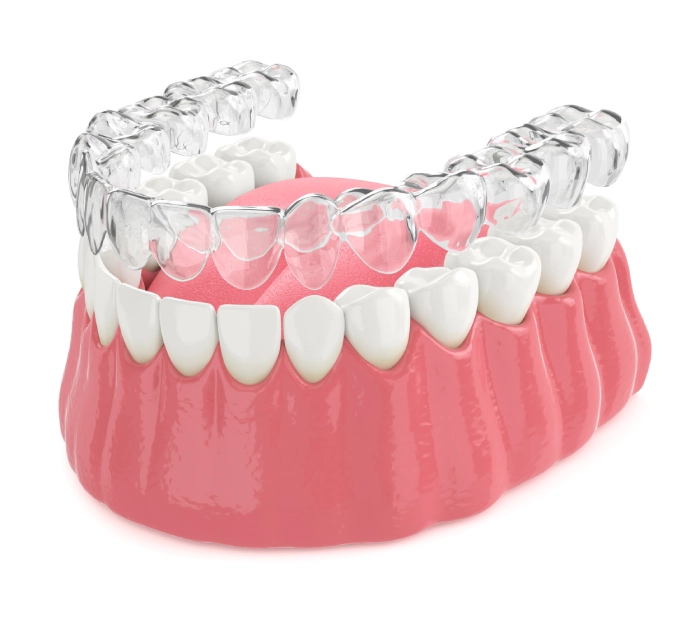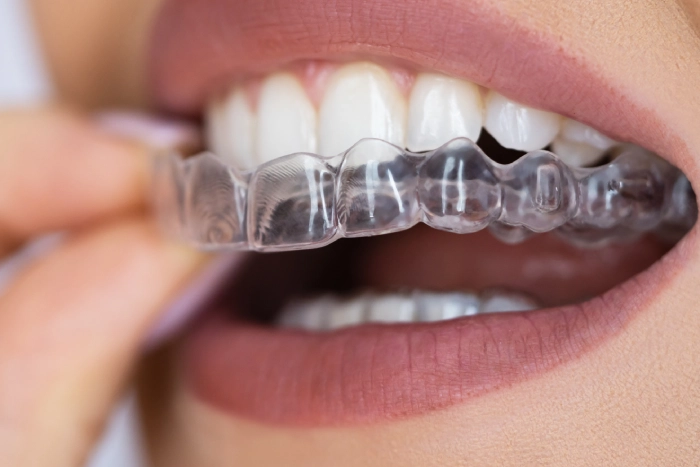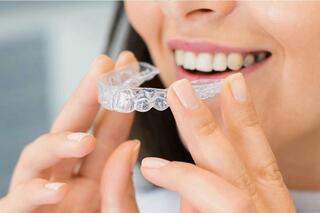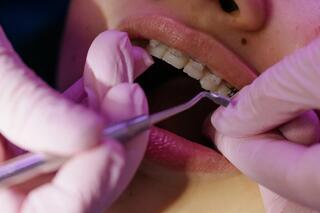What are Aligners?
A beautiful smile is now possible without braces - it's convenient, effective, and attractive.
Aligners are a painless, effective, and aesthetically pleasing way to correct improper bites. They are removable, clear silicone caps made according to an impression of your mouth. This method suits those who don't want to compromise their beautiful smiles and are reluctant to get braces.

When to Use and Not to Use Aligners
Orthodontic caps (aligners) are recommended for minor and moderate bite problems. They effectively correct defects caused by irregular tooth growth. However, they should be used cautiously in cases of open, mesial, or distal bite.
Indications
- Diastemas and gaps (spaces between the front teeth up to 4-5 mm);
- Overcrowding of teeth;
- Incorrect positioning of teeth (rotated, inclined, and protruding teeth).
Contraindications
- Complex bite issues related to jaw misalignments;
- Teeth that have not erupted through the gums;
- Periodontitis;
- Presence of implants and long dental bridges;
- Anomalies of the dental and temporal areas requiring surgical intervention;
- Age under 9 years.
Prices
The cost of treatment with aligners depends on several factors:
1. The complexity of the problem and the duration of correction determine the number of caps needed to correct the bite. Depending on the complexity, a different number of caps are required:
- Minor problems: 5-7 pieces;
- Mild cases: up to 10 pieces;
- Moderate cases: up to 20 pieces;
- Complex cases: from 21 to 35 pieces.
2. The choice of brand.
3. Necessary preparatory procedures.
The cost of aligning teeth with caps will be determined by the doctor in the clinic after examining the patient and analyzing the bite.
What is Invisalign and Where are They Made?
Invisalign is produced by Align Technology, the pioneer of removable systems for bite correction. It is the most famous and respected brand worldwide. Invisalign aligners have been in use for over 24 years.
Advantages:
- Reliable, long-lasting;
- Correct the bite effectively and quickly.
Disadvantages:
- Expensive: the highest prices in the market;
- Time-consuming process: produced in factories in Mexico and Costa Rica, then shipped to Russia. Delivery can take 1-1.5 months. Challenges may arise if a cap needs to be replaced due to loss or damage.
Steps of Teeth Alignment with Aligners
1. Examination, Consultation, Diagnosis.
During the consultation, the doctor assesses the condition of the mouth, identifies diseases, and rules out contraindications. An examination is conducted:
- An orthopantomogram, teleradiography, or computed tomography is performed. This is necessary to analyze the structure of the jaw, skull bones, the condition of the bone tissue, and the tooth roots. Based on this data, a treatment plan is created.
- Dental impressions are taken or a 3D scan of the jaw is performed.
- A photo protocol is created (photos of the patient's face from different angles and intraoral photos).
The collected data is sent to the manufacturer to create a 3D treatment model.
Duration: 1.5-2 hours.
2. 3D Modeling.
A few days later, the doctor shows the 3D model, which illustrates the step-by-step correction process. After approval, the caps are sent for production.
Duration: 1 hour.
3. Preparation of the Mouth.
Before the caps are installed, infections in the mouth are eliminated (caries, gum inflammation, deposits). Wisdom teeth are removed if necessary.
If there are no dental problems, only professional teeth cleaning is performed.
Duration: individual.
4. Installing Aligners.
Creating a customized set of orthodontic caps in the lab takes about 7-10 days. Once ready, the patient is invited for a session. The doctor fits the aligners, explains how to use and care for them, and schedules follow-up visits. In some cases, small attachments may be placed on the teeth.
Duration: up to 1 hour.
Treatment: The number of caps in the set depends on the steps in the 3D model. Usually, one cap is used for each step, which is worn for 1-2 weeks, as recommended by the doctor, and then replaced with the next one.
5. Monitoring Treatment Results
Every 2-3 months, a dental visit is necessary to assess the correction results. If needed, tooth separation (enamel filing) is performed.
Duration: 30 minutes.
6. Retention Stage.
To prevent teeth from shifting back, the doctor may recommend wearing a retainer cap during the day or night. Also, a fixed retainer may be installed – a metal wire on the inner side of the teeth.
Duration of Treatment with Aligners
The average treatment duration for moderate dental defects with aligners ranges from 12 to 18 months. Minor defects can be corrected faster – within 6-12 months. Visible changes are noticeable within 3-4 weeks. The retention stage lasts from 12 to 24 months.

It is important to wear orthodontic caps for 20-22 hours a day, removing them only for eating, drinking hot or staining beverages, and brushing teeth. Strict adherence to the wearing schedule is necessary, as prolonged absence of the caps in the mouth can affect the treatment results.
How a Set of Aligners is Made
The production of a custom set of orthodontic caps is done as follows:
- A virtual plan is created based on the data from the dental clinic (calculating the parameters and number of caps).
- An orthodontist reviews the program's calculations.
- Models of the jaws are printed on a 3D printer for each phase of the teeth's movement.
- Silicone caps are made based on these models in a vacuum former.
- The aligners are trimmed along the contours of the teeth and gums, processed, packaged, and sent to the clinic.
Advantages and Disadvantages
Removable systems for bite correction were introduced as an aesthetic alternative to traditional braces. Therefore, we compare the pros and cons of aligners with classic braces.
Advantages
- Enhanced Aesthetics: Aligners are easily removable during meals or important meetings. They look better than braces in the mouth.
- Low Trauma: Pain-free treatment that does not damage gums or mucous membranes.
- Visualization of Treatment Results: 3D modeling shows the final result.
- Easy Care: Easier to maintain than metal braces.
- Comfort and Convenience: Do not irritate the mucous membrane, do not affect speech, no dietary restrictions, comfortable for kissing.
- Low Risk of Enamel Damage: Do not cause cavities and stains on enamel, unlike braces.
- Hypoallergenic: No metal parts, no allergies, and no metallic taste.
Disadvantages
- Limitations in Complex Bite Defects: In complex cases, they can be ineffective or take longer.
- Less Control over Treatment: The outcome depends on the patient's discipline, less involvement by the doctor, difficult to make adjustments.
- High Cost: Treatment with aligners can be more expensive than with braces.
- High Patient Responsibility: Important to remember to wear and remove them, not lose them, and take them off before meals and hot drinks.
Aligners or Braces: Which is the Better Choice?
It's difficult to give a definitive answer to this question. Everything depends on the individual clinical situation and specific indications. Generally, in orthodontics, aligners are recommended for uncomplicated cases because they are more affordable and comfortable for the patient. For complex cases, braces are a better choice.
Despite manufacturers' claims that aligners can correct even complex bite pathologies, their use is sometimes not justified. Such treatment can take longer, be more expensive, less reliable, and less predictable. In such cases, orthodontists usually recommend metal or ceramic brace systems.
Frequently Asked Questions
What is Invisalign?
Invisalign is a brand of clear orthodontic aligners designed for the gradual straightening of teeth. Unlike traditional braces, they are less noticeable and can be more comfortable due to the absence of metal components.
Is Invisalign better than traditional braces?
Many people prefer Invisalign over traditional braces as they are less visible and generally more comfortable. Additionally, treatment often requires less time. Unlike metal braces, there are no issues with broken wires or brackets, reducing the need for emergency dental visits.
How does the Invisalign system work?
Invisalign involves a series of custom-made clear aligners that are changed periodically, usually every 1-2 weeks. Each aligner makes slight adjustments to the position of the teeth, gradually moving them into the desired alignment.
How much does Invisalign cost?
The cost varies depending on the complexity and duration of treatment but typically ranges from $3,500 to $8,000. Factors such as the severity of orthodontic issues and the length of treatment can affect the price.
Can both adults and children use Invisalign?
Invisalign is suitable for both adults and children. However, traditional braces may be recommended for very young children, depending on their age and ability to manage the aligners.
How long does it take to straighten teeth with Invisalign?
The duration of treatment varies. In mild cases, it may take as little as 6 months, while moderate to severe cases can take 12-18 months. This depends on the specific orthodontic needs of the patient.
Is it possible to switch from braces to Invisalign?
Switching from metal braces to Invisalign is sometimes possible, but it depends on individual circumstances. Generally, it is more effective and cost-efficient to start with Invisalign from the beginning.





